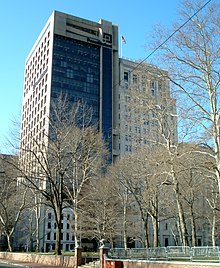Romaldo "Aldo" Giurgola AO was an Italian academic, architect, professor, and author. Giurgola was born in Rome, Italy in 1920. After service in the Italian armed forces during World War II, he was educated at the Sapienza University of Rome. He studied architecture at the University of Rome, completing the equivalent of a B.Arch. with honors in 1949. That same year, he moved to the United States and received a master's degree in architecture from Columbia University. In 1954, Giurgola accepted a position as an assistant professor of architecture at the University of Pennsylvania. Shortly thereafter, Giurgola formed Mitchell/Giurgola Architects in Philadelphia with Ehrman B. Mitchell in 1958. In 1966, Giurgola became chair of the Columbia University School of Architecture and Planning in New York City, where he opened a second office of the firm. In 1980 under Giurgola's direction, the firm won an international competition to design a new Australian parliament building. Giurgola moved to Canberra, Australia to oversee the project. In 1989, after its completion and official opening in 1988, the Parliament House was recognised with the top award for public architecture in Australia.
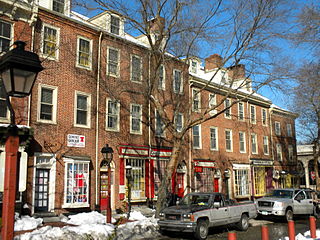
Society Hill is a historic neighborhood in Center City Philadelphia, Pennsylvania, United States, with a population of 6,215 as of the 2010 United States Census. Settled in the early 1680s, Society Hill is one of the oldest residential neighborhoods in Philadelphia. After urban decay developed between the late 19th and early 20th centuries, an urban renewal program began in the 1950s, restoring the area and its many historic buildings. Society Hill has since become one of the most expensive neighborhoods with the highest average income and second-highest real estate values in Philadelphia. Society Hill's historic colonial architecture, along with planning and restoration efforts, led the American Planning Association to designate it, in 2008, as one of the great American neighborhoods and a good example of sustainable urban living.

Sedgwick station is a SEPTA Regional Rail station at 253 East Mount Pleasant Avenue between Sprague and Devon Streets in Philadelphia, Pennsylvania. The old station building was built in 1882 with Furness & Evans as the architect, but was damaged in an arson fire around 1980 and demolished. The current station facility consists of low level platforms with open shelters. A walkway under the tracks was sealed off due to criminal activity.
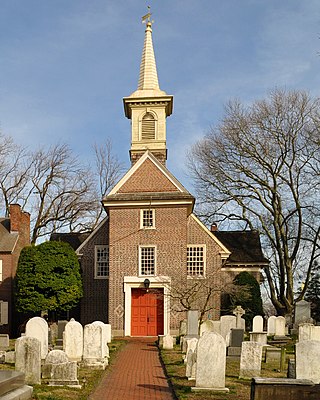
The architecture of Philadelphia is a mix of historic and modern styles that reflect the city's history. The first European settlements appeared within the present day borders of Philadelphia, Pennsylvania in the 17th century with most structures being built from logs. By the 18th century, brick structures had become common. Georgian and later Federal style buildings dominated much of the cityscape. In the first half of the 19th century, Greek revival appeared and flourished with architects such as William Strickland, John Haviland, and Thomas U. Walter. In the second half of the 19th century, Victorian architecture became popular with the city's most notable Victorian architect being Frank Furness.

The University of Pennsylvania Campus Historic District is a historic district on the campus of the University of Pennsylvania, in Philadelphia, Pennsylvania, USA. The university relocated from Center City to West Philadelphia in the 1870s, and its oldest buildings date from that period. The Historic District was added to the National Register of Historic Places on December 28, 1978. Selected properties have been recorded by the Historic American Buildings Survey, as indicated in the table below.

Theophilus Parsons Chandler Jr. was an American architect of the late 19th and early 20th centuries. He spent his career at Philadelphia, and is best remembered for his churches and country houses. He founded the Department of Architecture at the University of Pennsylvania (1890), and served as its first head.
Zantzinger, Borie and Medary was an American architecture firm that operated from 1905 to 1950 in Philadelphia. It specialized in institutional and civic projects. For most of its existence, the partners were Clarence C. Zantzinger, Charles Louis Borie Jr., and Milton Bennett Medary, all Philadelphians.

Jewelers' Row, located in the Center City section of Philadelphia, Pennsylvania, United States, is composed of more than 300 retailers, wholesalers, and craftsmen located on Sansom Street between Seventh and Eighth Streets, and on Eighth Street between Chestnut and Walnut Streets.
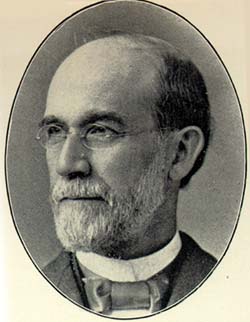
Addison Hutton (1834–1916) was a Philadelphia architect who designed prominent residences in Philadelphia and its suburbs, plus courthouses, hospitals, and libraries, including the Ridgway Library, now Philadelphia High School for the Creative and Performing Arts, and the Historical Society of Pennsylvania. He made major additions to the campuses of Westtown School, George School, Swarthmore College, Bryn Mawr College, Haverford College, and Lehigh University.

John McArthur Jr. (1823–1890) was a prominent American architect based in Philadelphia. Best remembered as the architect of the landmark Philadelphia City Hall, McArthur also designed some of the city's most ambitious buildings of the Civil War era. Few of his buildings survive.

The Provident Life & Trust Company is a demolished Victorian-era building in Philadelphia designed by architect Frank Furness and considered to be one of the famed architect's greatest works. A bank and insurance company founded in 1865 by members of the Society of Friends (Quakers), the Provident's L-shaped building had entrances at 407–09 Chestnut Street, which served as the entrance to the bank, and at 42 South 4th Street, which was the entrance to the insurance company. The two wings were eventually consolidated into an office building, also designed by Furness, at the northwest corner of 4th and Chestnut Streets.
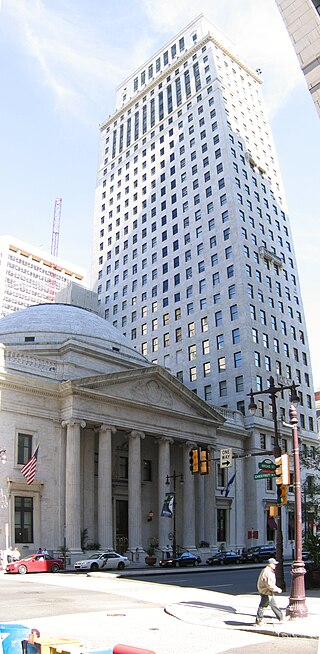
The Ritz-Carlton Philadelphia is a luxury hotel and residential complex that is located in Center City, Philadelphia, Pennsylvania, United States. It comprises three adjoining buildings: the Girard Trust Bank, at the northwest corner of South Broad and Chestnut Streets, the Girard Trust Building, at the southwest corner of South Broad Street and South Penn Square, and The Residences at the Ritz Carlton, at 1414 South Penn Square.
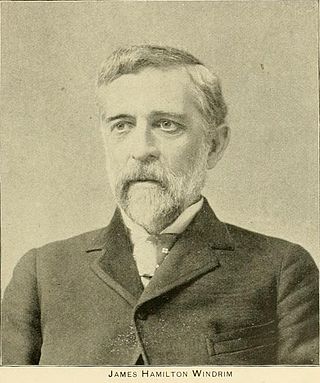
James Hamilton Windrim was a Philadelphia architect who specialized in public buildings, including the Masonic Temple in Philadelphia and the U.S. Treasury. A number the buildings he designed are on the National Historic Landmarks and/or the National Register of Historic Places, including the Masonic Temple in Philadelphia and the National Savings and Trust Company building in Washington, DC.

The Land Title Building and Annex is an American early skyscraper located at 1400 Chestnut Street in Philadelphia, Pennsylvania. The building was listed on the National Register of Historic Places in 1978.

Plymouth Meeting Historic District is a national historic district that straddles Plymouth and Whitemarsh Townships in Montgomery County, Pennsylvania, United States. The adjacent Cold Point Historic District is north of it.
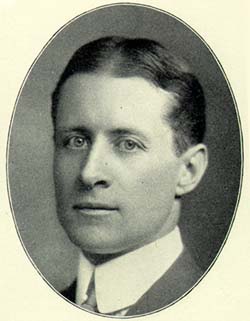
Edgar Viguers Seeler (1867–1929) was an American architect.
Clarence Clark Zantzinger (1872-1954) was an architect and public servant in Philadelphia, Pennsylvania.

Edward Maene was a Belgian-American architectural sculptor, woodcarver and cabinetmaker.

Mellor, Meigs & Howe (1916–28) was a Philadelphia architectural firm best remembered for its Neo-Norman residential designs.

Allen Evans was an American architect and partner in the Philadelphia firm of Furness & Evans. His best known work may be the Merion Cricket Club.

